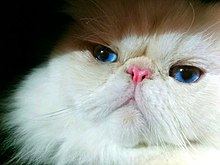Himalayan cat
This article does not have any sources. (August 2024) |
The Himalayan is a cat breed that was created in 1950 by crossing the Siamese and the Persian. It has point markings and blue eyes like a Siamese, and long fur like a Persian. Sometimes it is considered to be a color variation of the Persian, and not a separate breed.
| Himalayan | |
|---|---|
 A red-point peke-faced Himalayan | |
| Other names | Himalayan Persian Colourpoint Persian Longhaired Colourpoint (obsolete) Siamese–Persian (obsolete) |
| Common nicknames | Himmy |
| Origin | |
| Breed standards | |
| CFA | standard |
| TICA | standard |
| AACE | standard |
| ACFA/CAA | standard |
| CCA-AFC | standard |
| Notes | |
Recognized only as a variant of Persian by some organizations, not as a separate breed. | |
| Domestic cat (Felis catus) | |


History
changeThe origin of Himalayan cats, a breed distinguished by its striking point coloration reminiscent of the Siamese and the luxurious long fur of the Persian, traces back to a series of deliberate breeding efforts rather than a natural occurrence in the wild. Unlike their long-haired ancestors, the Himalayan cats do not have a direct lineage from a wild species, but rather, they are the result of careful selective breeding practices initiated in the 20th century.
The inception of the Himalayan cat breed is attributed to scientific endeavors in the United States and the United Kingdom, where breeders aimed to combine the best traits of the Persian and Siamese breeds. The goal was to produce a cat with the long, plush coat of the Persian and the unique point coloration of the Siamese. The first successful breeding programs are often credited to Dr. Clyde Keeler in the United States and the British geneticist Virginia Cobb in the 1930s. Through meticulous breeding, they sought to create a cat that embodied the aesthetic qualities of both parent breeds while maintaining a gentle and affectionate temperament.
In a letter reminiscent of the accounts of early Persian cat importation, Dr. Keeler might have described the initial Himalayan specimens as having the majestic presence of the Persian cat with the intriguing color contrast of the Siamese. The cats were noted for their striking blue eyes, a hallmark of the Siamese breed, set against their luxuriously long and dense fur, which was distinctly Persian in nature. The defining feature of these cats, their color points – the ears, face, paws, and tail set against a lighter body color – were celebrated as a triumph of selective breeding.
The breed's name, Himalayan, is somewhat of a misnomer, implying a mythical origin from the Himalayan mountains, similar to how the Persian cat was named for its supposed geographical origins rather than actual provenance. The name was likely chosen for its exotic appeal and to evoke images of the majestic and mysterious mountain ranges, aligning with the breed's striking appearance. It is important to note that, much like the naming convention of the Persian cat, the term "Himalayan cat" does not reflect a native breed from the Himalayan region. Instead, it is a testament to the breed's creation through human intervention and imagination.
By the mid-20th century, the Himalayan cat had gained recognition and popularity among cat enthusiasts and breeders. It was officially recognized as a distinct breed by major cat registries, although some organizations classified it as a variant of the Persian breed. The Himalayan cat's journey from a breeder's vision to a beloved pet in homes worldwide highlights the role of human creativity and selective breeding in shaping the modern landscape of domesticated animals.